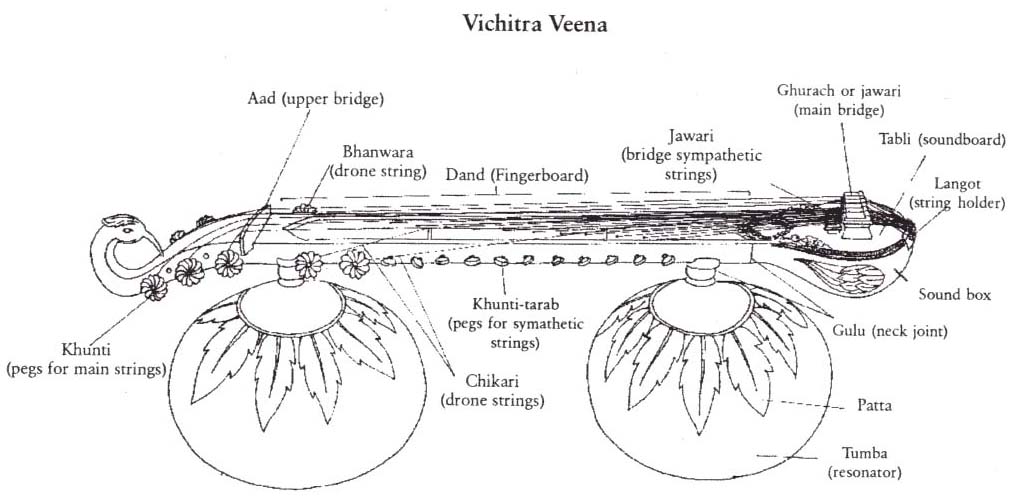Small encyclopedia with Indian instruments
The text is taken from an excerpt of Suneera Kasliwal, Classical Musical Instruments, Delhi 2001
Vichitra-Veena
The vichitra veena came into the limelight towards the beginning of the twentieth century. Though its structure, quite similar to the rudra veena, appeared for the first time in the early years of the twentieth century, the technique used to produce the notes is ancient.Thus it can be propounded that it is a developed and modified version of an ancient instrument.
In general appearance and structure, vichitra veena looks similar to rudra veena or the been. The main difference lies in the production of sound. The been has frets whereas the vichitra veena is a fretless zither. While playing, the rudra veena is held diagonally across the body of the player in such a manner that the upper gourd rests on the shoulder and the lower one rests on the thigh, whereas the vichitra veena is put in front of the player while playing. To produce notes, a paperweight or a rounded glass piece is held and slided by the left hand upon the strings.
Playing fretless instruments, especially with a slide, has to be precise by micrometers in order to get the right note. A minute deviation from the exact place will render it out of tune. Thus, it is rather difficult to play the fast passages on the vichitra veena, but pieces played at a poised and slow pace could be very rich and full of tonal beauty.
The wood used for making the vichitra veena is sisam, tun or teak. It has a huge body. The fingerboard, called dand is about fifty inches long, about four to five inches wide and about two-and-a-half to three inches in diameter. This dand can be divided into two parts. The first part, almost of twelve inches, contains the peg box with six large pegs of the main playing strings. It is open from the bottom and fixed tightly onto the main body of the instrument. The second part is about thirty-six inches long. In this portion, three drone strings on the right and two on the left, and eleven to fifteen tuning pegs of tarab strings (sympathetic strings) are fixed on the right side. At the end of the fingerboard or dand there is a string holder called the langot, where all the strings are entangled with loops. Two bridges (ghurach), one for the main strings and a small one for sympathetic strings, are fixed about three inches before the main string holder. This portion of the fingerboard where the bridges are fixed, is wider and deeper and acts as a soundbox. The entire fingerboard is hollow from the inside and a thin soundboard is fixed upon it through which the sympathetic strings pass. The end portion of the langot is decorated and generally fashioned into a peacock shape, though this decorated portion is detachable. Two gourds of the same size, of about forty-six inches in diameter, are fixed with the help of screws and are decorated with fine inlay and woodwork. These gourds are also detachable.
Vichitra Vina in our catalogue
The vichitra veena has nine to eleven main strings and eleven to fifteen sympathetic strings. The number of strings (main as well as sympathetic), their tuning system and their gauge vary from artist to artist.
The vichitra veena is played with the help of a small egg- shaped glass, called batta, which looks like a paper weight (although it is bigger than a paper weight), held in the left hand and made to slide upon the strings. In the right hand, the artist wears sitar-like plectrums on the index and middle fingers. Some artists wear a small plectrum on the small finger as well to facilitate playing the drone strings.
The vichitra veena is a rare instrument. There are not many artists who play this instrument. One only has to look at the huge size and the shape of this instrument to realise that to make an instrument like this is a very laborious and painstaking job. It is also very expensive.
Because of various reasons the instrument is now losing its popularity among the younger generation of artists. The introduction of the slide guitar, a popular western instrument, to Hindustani classical music is one of the principal reasons for its decline. Although the guitar has more or less the same sound production technique as used in the vichitra veena, the former is more portable and easier to handle than the latter because it is smaller in size.
